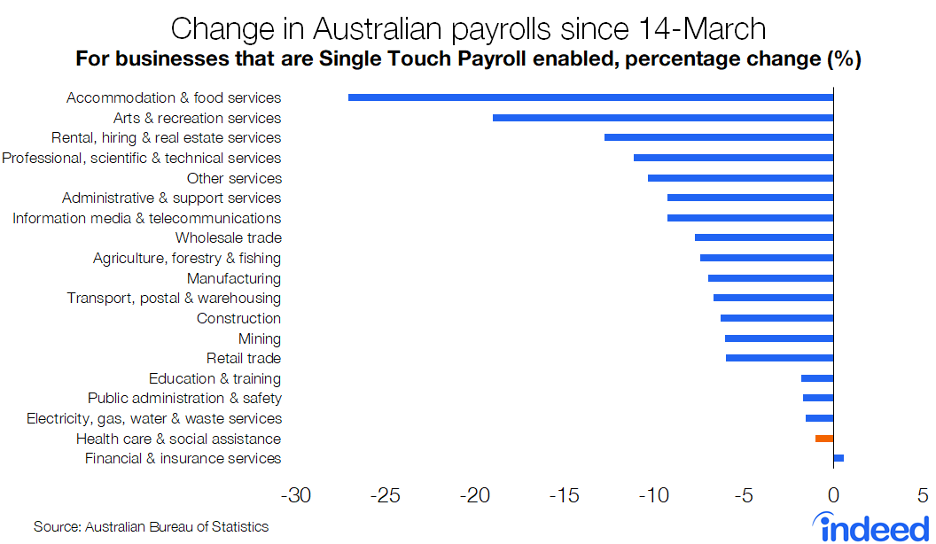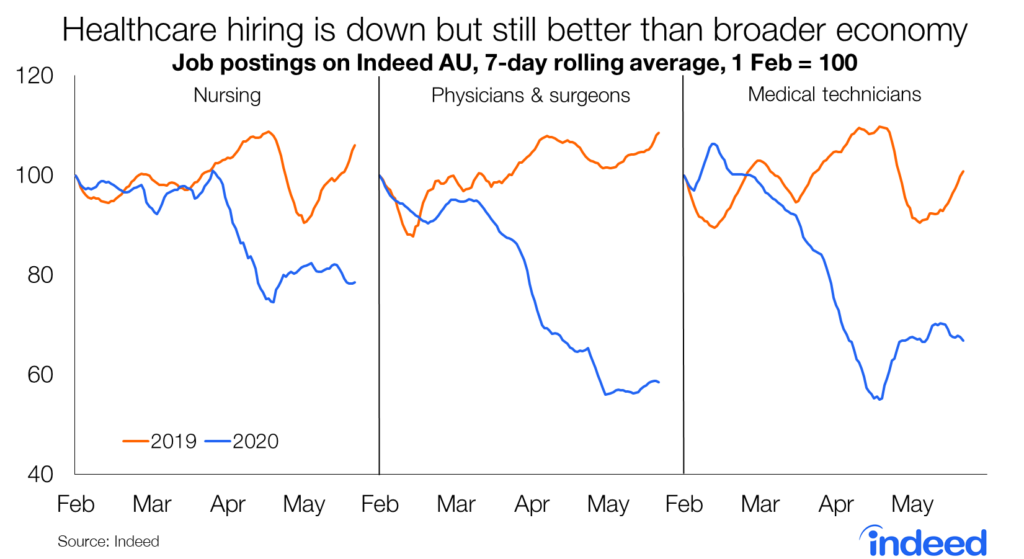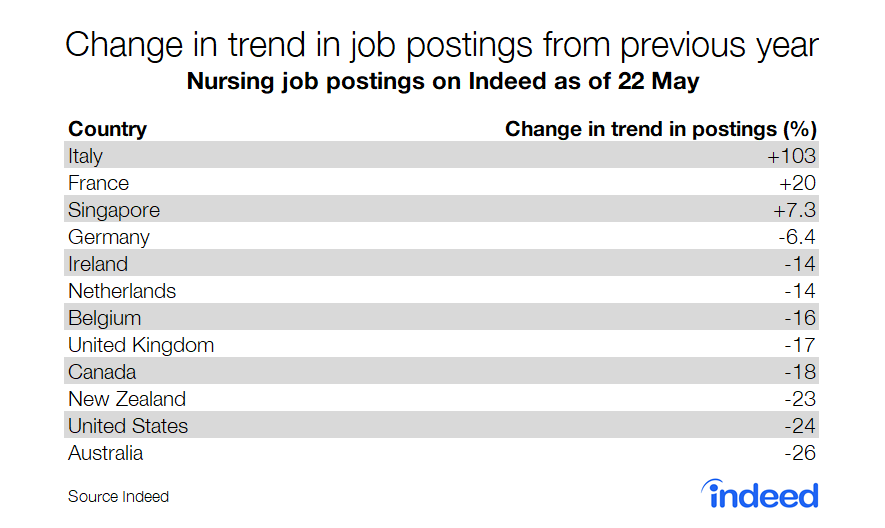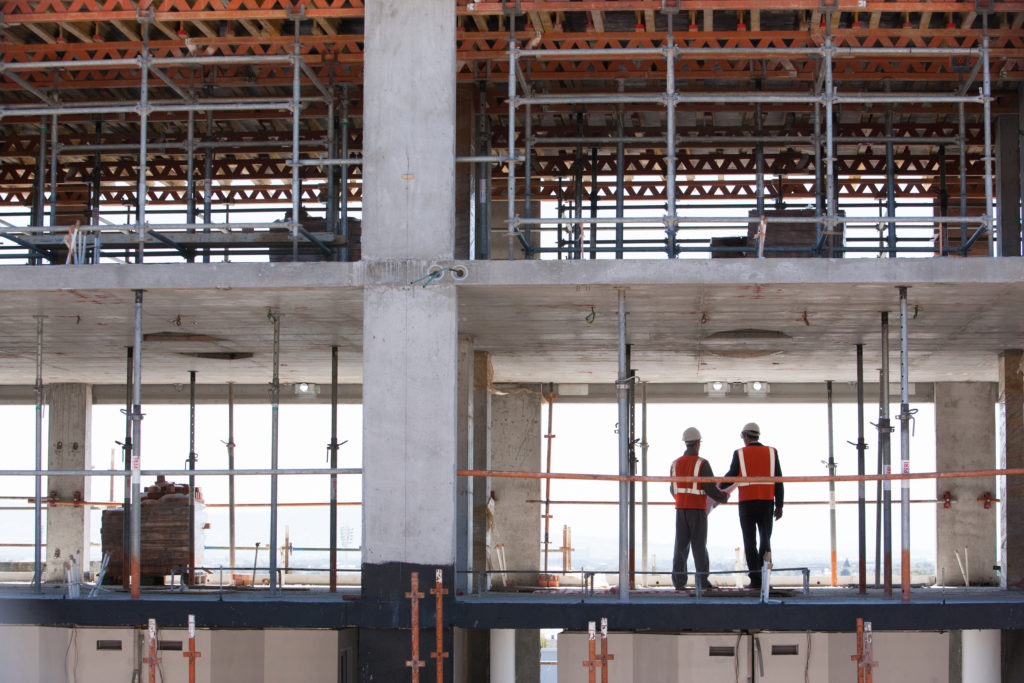Key findings:
- Payrolls in healthcare and social assistance declined 1.0% between March 14 and May 2 this year, less than the overall 7.3% drop in Australian payrolls.
- Every sector has experienced a fall in hiring, but only one has held up better than nursing.
- Fewer postings for healthcare professionals could be viewed positively to the extent that it reflects Australia’s success in ‘flattening the curve’.
The COVID-19 pandemic was expected to push Australia’s already-stretched healthcare system, which directly employs one million people, to its limits. Before the crisis, labour shortages were already apparent across a range of healthcare professions, including nurses and doctors, creating fears that the healthcare system would be overwhelmed.
Those fears have faded. Australia has ‘flattened the curve’ better than most countries and, in the process, built additional capacity throughout the healthcare system to manage another outbreak should one occur.
Hiring across the healthcare sector slowed throughout March and April, albeit not to the same degree as in most other areas of the economy. Further moderation has occurred throughout May, while starting to improve in other sectors. Moreover, a fall in healthcare job postings may be positive to the extent that it reflects our success in containing the outbreak.
Healthcare has been a standout performer during the COVID-19 crisis
Business payrolls in healthcare and social assistance fell 1.0% between March 14 and May 2 compared with a 7.3% decline in the Australian economy as a whole. The healthcare and social assistance category has experienced the second-smallest change in payrolls out of 19 industry groups, trailing only financial services.

The healthcare and social assistance sector covers a wide variety of jobs, not just obvious occupation categories as nurse and doctor. It takes in everyone who works for a healthcare or care service provider or organisation. For example, it includes an accountant or administrative assistant at a private healthcare provider. Healthcare in particular accounts for around 58% of employment in the category.
Some roles within the healthcare industry are likely to be more at risk from COVID-19 than others. Unfortunately, the available ABS data was created on short notice to measure the impact of COVID-19 and only indicates which industry groups have fared best. Information on specific occupations is not available.
Healthcare hiring softened in April despite the crisis
Indeed job posting data provides great detail on hiring activity, though it doesn’t offer information on job losses. The data show that hiring of healthcare professionals has declined noticeably compared with last year, albeit less than Australian hiring as a whole.
Nursing has been the second-least-affected occupation, just behind drivers, with job postings tracking 26% below last year. Demand for nurses held up throughout March, in line with last year’s trend, when concern over our capacity to deal with COVID-19 was high. The federal government even relaxed student nurse visa work restrictions that month. Since then though, as the pandemic has come under control, healthcare providers have dampened hiring.
Postings in the physicians and surgeons and medical technicians categories fell more, with both now a little better than the national average for all occupations. Of course, doctors are important for treating COVID-19 cases. But surgeons have no longer been as necessary because many elective procedures have been temporarily postponed.

Hiring for nurses lower in Australia than in comparable countries
Demand for nurses has varied considerably across the globe. Nurse job postings are tracking a full 103% higher than last year’s trend in Italy and 20% higher in France. Meanwhile, they are tracking 6.4% below last year in Germany and 14% lower in both Ireland and the Netherlands.
Hiring of nurses in Australia and New Zealand has declined to a greater extent than in most other countries. There may be many reasons since healthcare systems vary across the globe. One factor could simply be that Australia and New Zealand have had more success containing COVID-19 and therefore haven’t needed additional staff to meet surging demand for healthcare services.

Assessment
Healthcare has been one of Australia’s boom sectors over the past half-decade, accounting for 14% of all employment gains and registering employment growth twice as high as the rest of the economy. Finding sufficient talent has been difficult, with labour shortages plaguing the industry for years. Addressing these shortages is often challenging since many of the positions require extensive education and qualifications.
Consequently, the healthcare sector faced a genuine risk that it would be overwhelmed had Australia failed to contain COVID-19, as occurred in some other countries. It may be that the decline in hiring of nurses and doctors is one of those rare situations in which lower hiring is a good sign.
Methodology
To measure trends in job postings, we calculated the seven-day moving average of the number of AU job postings on Indeed. We index each day’s seven-day moving average to 1 Feb for that year (1 Feb, 2020 = 100 for 2020 data, and so on), or another date if specified on the chart.
We report how the trend in job postings this year differs from last year’s trend in order to focus on recent changes in labour market conditions due to COVID-19. For example, if job postings for a country increased 5% from 1 February, 2019, to 28 March, 2019, but fell 25% from 1 February, 2020, to 28 March, 2020, then the index would have risen from 100 to 105 in 2019 and fallen 100 to 75 in 2020. The year-to-date trend in job postings would therefore be down 29% on 28 March, (75 is 29% below 105) 2020, relative to the comparable period in 2019.
We have focused on three distinct job posting sectors: nurses, physicians and surgeons and medical technicians.
Analysis based on publicly available information on the Indeed AU website, limited to Australia, is not a projection of future events and includes both paid and unpaid job solicitations.






